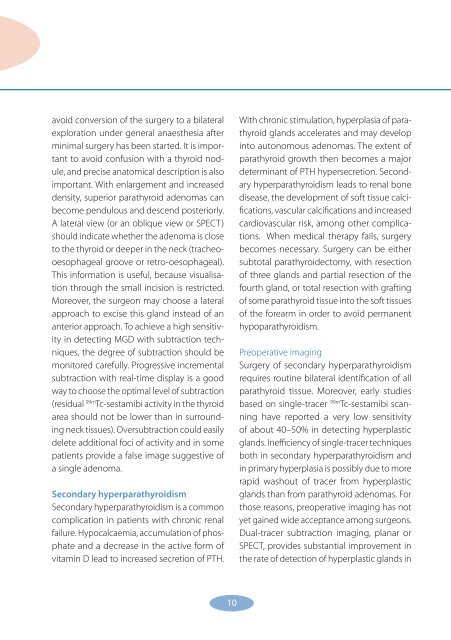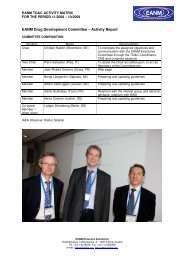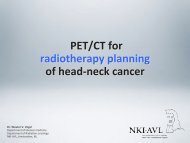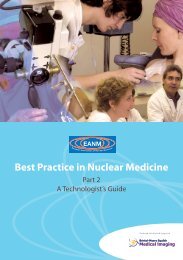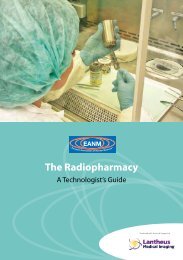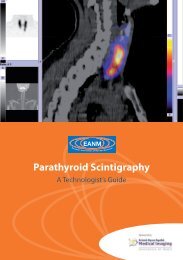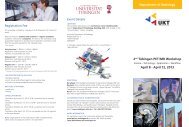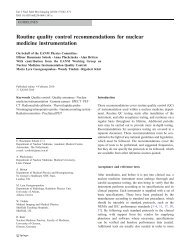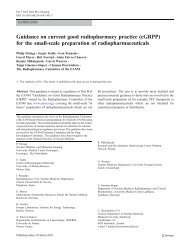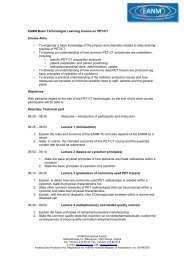Parathyroid Scintigraphy - European Association of Nuclear Medicine
Parathyroid Scintigraphy - European Association of Nuclear Medicine
Parathyroid Scintigraphy - European Association of Nuclear Medicine
You also want an ePaper? Increase the reach of your titles
YUMPU automatically turns print PDFs into web optimized ePapers that Google loves.
avoid conversion <strong>of</strong> the surgery to a bilateral<br />
exploration under general anaesthesia after<br />
minimal surgery has been started. It is important<br />
to avoid confusion with a thyroid nodule,<br />
and precise anatomical description is also<br />
important. With enlargement and increased<br />
density, superior parathyroid adenomas can<br />
become pendulous and descend posteriorly.<br />
A lateral view (or an oblique view or SPECT)<br />
should indicate whether the adenoma is close<br />
to the thyroid or deeper in the neck (tracheooesophageal<br />
groove or retro-oesophageal).<br />
This information is useful, because visualisation<br />
through the small incision is restricted.<br />
Moreover, the surgeon may choose a lateral<br />
approach to excise this gland instead <strong>of</strong> an<br />
anterior approach. To achieve a high sensitivity<br />
in detecting MGD with subtraction techniques,<br />
the degree <strong>of</strong> subtraction should be<br />
monitored carefully. Progressive incremental<br />
subtraction with real-time display is a good<br />
way to choose the optimal level <strong>of</strong> subtraction<br />
(residual 99m Tc-sestamibi activity in the thyroid<br />
area should not be lower than in surrounding<br />
neck tissues). Oversubtraction could easily<br />
delete additional foci <strong>of</strong> activity and in some<br />
patients provide a false image suggestive <strong>of</strong><br />
a single adenoma.<br />
Secondary hyperparathyroidism<br />
Secondary hyperparathyroidism is a common<br />
complication in patients with chronic renal<br />
failure. Hypocalcaemia, accumulation <strong>of</strong> phosphate<br />
and a decrease in the active form <strong>of</strong><br />
vitamin D lead to increased secretion <strong>of</strong> PTH.<br />
10<br />
With chronic stimulation, hyperplasia <strong>of</strong> parathyroid<br />
glands accelerates and may develop<br />
into autonomous adenomas. The extent <strong>of</strong><br />
parathyroid growth then becomes a major<br />
determinant <strong>of</strong> PTH hypersecretion. Secondary<br />
hyperparathyroidism leads to renal bone<br />
disease, the development <strong>of</strong> s<strong>of</strong>t tissue calcifications,<br />
vascular calcifications and increased<br />
cardiovascular risk, among other complications.<br />
When medical therapy fails, surgery<br />
becomes necessary. Surgery can be either<br />
subtotal parathyroidectomy, with resection<br />
<strong>of</strong> three glands and partial resection <strong>of</strong> the<br />
fourth gland, or total resection with grafting<br />
<strong>of</strong> some parathyroid tissue into the s<strong>of</strong>t tissues<br />
<strong>of</strong> the forearm in order to avoid permanent<br />
hypoparathyroidism.<br />
Preoperative imaging<br />
Surgery <strong>of</strong> secondary hyperparathyroidism<br />
requires routine bilateral identification <strong>of</strong> all<br />
parathyroid tissue. Moreover, early studies<br />
based on single-tracer 99m Tc-sestamibi scanning<br />
have reported a very low sensitivity<br />
<strong>of</strong> about 40–50% in detecting hyperplastic<br />
glands. Inefficiency <strong>of</strong> single-tracer techniques<br />
both in secondary hyperparathyroidism and<br />
in primary hyperplasia is possibly due to more<br />
rapid washout <strong>of</strong> tracer from hyperplastic<br />
glands than from parathyroid adenomas. For<br />
those reasons, preoperative imaging has not<br />
yet gained wide acceptance among surgeons.<br />
Dual-tracer subtraction imaging, planar or<br />
SPECT, provides substantial improvement in<br />
the rate <strong>of</strong> detection <strong>of</strong> hyperplastic glands in


